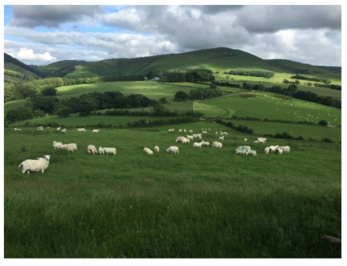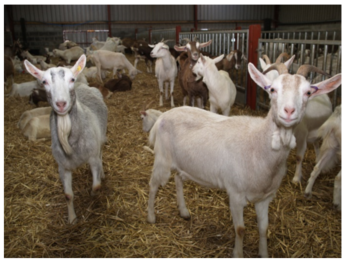Dr William Stiles: IBERS, Aberystwyth University.
Take home messages:
- Climate change will have strong effects on pastoral production in the UK.
- Implementing management approaches to allow these systems to adapt to this future environmental change is essential.
- This will increase the potential for farm business resilience and for future food security.
Adapting UK farm systems to climate change is a major challenge, which is multifaceted and will require action for all aspects of grassland-livestock production. Responding to the challenges offered by climate change is essential, as future demand for food production is predicted to increase by around 60% by 2050, as a consequence of global population increase.
Climate change has the potential to influence numerous elements of the ruminant livestock production process. Even subtle shifts in climate can have surprising and significant resultant or associated effects, which need to be considered and, for certain scenarios, actively managed.
Forage and feed
Pressures on forage crop production are expected to vary between southern and northern regions in the UK as a result of local differences in the impact of climate change. In northern areas, crop production is expected to increase as a result of rising atmospheric CO2 concentrations, coupled with increased precipitation and extended growing seasons. In southern regions, pressures associated with reduced water availability and increased heat stress are expected to be the primary factors which have the
potential to impact production. For the UK as a whole, grass growth is expected to increase as a result of climate change, (presuming water and nitrogen supplies remain adequate) with yield increases estimated to be in the region of 15% per degree of warming.
However, for both northern and southern regions, it is also possible that yields will be reduced even in situations where water is not a limiting factor, as greater heat may lead to increased photorespiration and reduced photosynthesis. Adaptive strategies designed to manage these effects orientate around optimising planting and growing times, such as early sowing to avoid the hottest period, or crop species selection, such as selecting cultivars which are more heat tolerant. Novel approaches, such as intercropping or mulching to allow maximum use and retention of available soil moisture, may also offer potential management strategies.
Increased incidence of pest or disease outbreak among forage crops, both from existing and emerging pests and diseases, is also likely as a consequence of climate change. This could affect the home-grown food resource potential for livestock and increase the reliance on foreign supply chains. The use of more disease or pest resistant cultivars has been suggested as a possible strategy. Whilst this undoubtedly has a role in managing this potential issue, the reliance on such approaches could be perilous over time, as this may drive strong selective traits amongst pest and disease species to overcome plant defences. Alternatively, strategies that introduce greater genetic variability, both within and between cultivars, may offer more stability in the long term, as this mimics the broader genetic basis for resistance in natural communities. In the short term, a more sustainable integrated strategy for pesticide usage may need to be developed, which considers factors such as potential for crossover into human food chains. This in turn will need to be advised by a greater understanding of likely future threats from pest and disease species.
In addition to the predicted variability in forage production within Europe, there is potential for volatility in animal feed supply chains from other countries. Increased global demand and competition, coupled with reductions in supply because of climate change, are likely to drive price increases and reduce availability. Greater focus on home-grown vegetable protein for animal feed to ensure self-sufficiency is needed across Europe, which could incorporate novel legume crops such as lupins. This may necessitate a shift towards more mixed farming systems in the future.
Water resources
The future for water resources across Europe and the UK under climate change is expected to be characterised by increased magnitude and frequency of extreme rainfall events and droughts. Differences with regard to water resources in north and south Europe are also expected to widen, which may have significant impact on Europe wide agricultural production, leading to increased future reliance on production within northern European countries.
In the UK, changes in water availability and potential restrictions on water usage may have a substantial effect on agricultural production, particularly in more southerly regions. In these regions, the challenge will be characterised by increased demand for water use, alongside reduced water availability and supply, increased flood risk, and longer, more frequent droughts. These factors are likely to result in greater vulnerability in terms of agricultural production. Thus, the development of systems with enhanced water use efficiency will be of critical importance. In southern areas more prone to drought, management practices which maximise available water resources will be essential. For the most extreme scenarios, these could include the use of crops with high thermal tolerance and low water usage requirements, investment in rain water harvesting technologies to maximise overwinter water collection, switching to management practices such as overnight watering to reduce losses from irrigation, and methods to exploit the water holding capacity of soils to reduce the need for irrigation, such as management approaches to increase soil organic carbon (C) levels.
In northerly regions, climate change is expected to increase water supply, reducing water demand. However, any perceived benefit needs to be weighed against the greater potential for flood events. Waterlogged land will affect livestock production directly, through increased rates of lameness and through the loss of land for forage production, and indirectly, through increased housing requirements and costs, including expenses for additional feed and bedding, and through higher incidence rates of parasites such as liver fluke Fasciola hepatica, which benefit from wetter conditions.
Adapting farmlands to the increased risk of flooding and waterlogging can be undertaken both by instigating management approaches which aim to reduce the potential for flood events and by adopting practices that anticipate the impacts of flooding, such as the sufficient provision of stock housing. Farm-level management approaches could be tailored to reduce the frequency and size of flood events, by limiting the potential for runoff or overland flow, and by slowing the movement of water from soil to watercourses. This can be achieved by employing management techniques such as contour ploughing, or through the improvement of soil structure (i.e. by reducing the effects of compaction), and by increasing the presence of hedgerows and tree shelterbelts on farms to increase water infiltration rates. These on-farm strategies are only part of the picture, but are essential components of wider management strategies at the catchment scale.
Livestock
Greater incidence of heat stress in livestock in the UK is only likely to be a regular problem for more southerly regions, however, as extreme high temperature events become increasingly more common, it may affect all livestock production. This can result in the loss of productivity through reductions in food intake, increases in respiratory effort, increased sweating and changes to blood acid base balance. These physiological responses can limit growth, reduce fertility, lower milk yield and reduce meat quality.
As with crop species, selecting livestock breeds that are more heat tolerant is one solution, however
livestock breeds that are more heat tolerant are potentially less productive. The use of species such as goats, which are less susceptible to heat stress, may also offer an alternative option for dairy production. For regions where the potential for heat stress is greatest, investment in infrastructure, such as additional housing, may become necessary to house ruminants in summer periods to avoid the worst effects of heat stress. Lastly, alternative approaches to grassland and pasture management, such as agroforestry, may offer more cost sensitive solutions to heat stress management (potentially necessary for smaller farm operations) by providing shade and shelter resources for livestock. Such an approach may also offer concurrent benefits with regard to soil management or flood mitigation, thus offering an opportunity to instigate a more integrated strategy for farm based adaptation, which should be an important future focus when considering adaptation methods.
Climate change is expected to increase the spread and occurrence of pests and pathogens, which will affect both livestock and forage crop species. Shifts in climate can influence numerous factors that govern pest and pathogen distribution and prevalence, including temperature and moisture levels. As the climate changes, the traditional ranges of pests and diseases will be modified and periods of activity may be increased. In situations of increased temperature, the dispersal potential of insects may be augmented and the survival of viruses in the environment enhanced. Shifts in patterns for temperature, UV exposure and rainfall will all influence the survival rate of larval stages of gastro-intestinal parasites found in pasture. A probable likelihood of shifts in climate and rainfall pattern, particularly for northern regions, is increased seasonality of infection rates. Increased incidence of spring and autumn infections is likely, as these months become wetter and peak summer months grow hotter and drier.
Early warning, early detection, and early response are key to the prevention and control of both old and new pests and diseases. Livestock production systems will therefore require a greater understanding of these potential future shifts in seasonality to allow for better prediction and anticipation of infection events. In addition, better disease surveillance and stock health monitoring will be necessary and can be achieved through several emerging technologies, capable of automated herd health assessments. Increased housing provision may also be needed to avoid key infection periods, by reducing exposure to infections in pasture. However, this may also increase infection rates for some diseases, due to the proximity of animals relative to one another during housing, which may increase the spread of disease amongst the herd. For extreme outbreak scenarios, vaccination programs, for both domestic livestock and wildlife populations, may become necessary.
Summary
The effects of climate change on UK livestock production systems, particularly grassland-ruminant systems, are wide ranging and could offer both benefits and costs in the context of agricultural production. On-farm adaptation methods are therefore of increasing importance to enable farmers to meet these challenges and to develop farming systems which are robust to future shifts in climate.
Increasing the understanding of decision makers with regard to the effects of climate change is perhaps the most important adaptation strategy. By improving recognition of the impacts and influences of climate on their systems, land managers may be able to effectively instigate management strategies to reduce or mitigate any negative influence.
From a Welsh perspective, it is likely that our grassland-livestock production systems will be net beneficiaries from this shift in climate, as this translates into increased future grass yields. Nevertheless, in the context of wider European livestock production, and the need for future food security, gains in northern countries may well be offset by reductions in productivity further south. Thus, the need to maximise production where possible, whilst reducing the environmental impact and the current emission of GHGs, is of critical importance.


